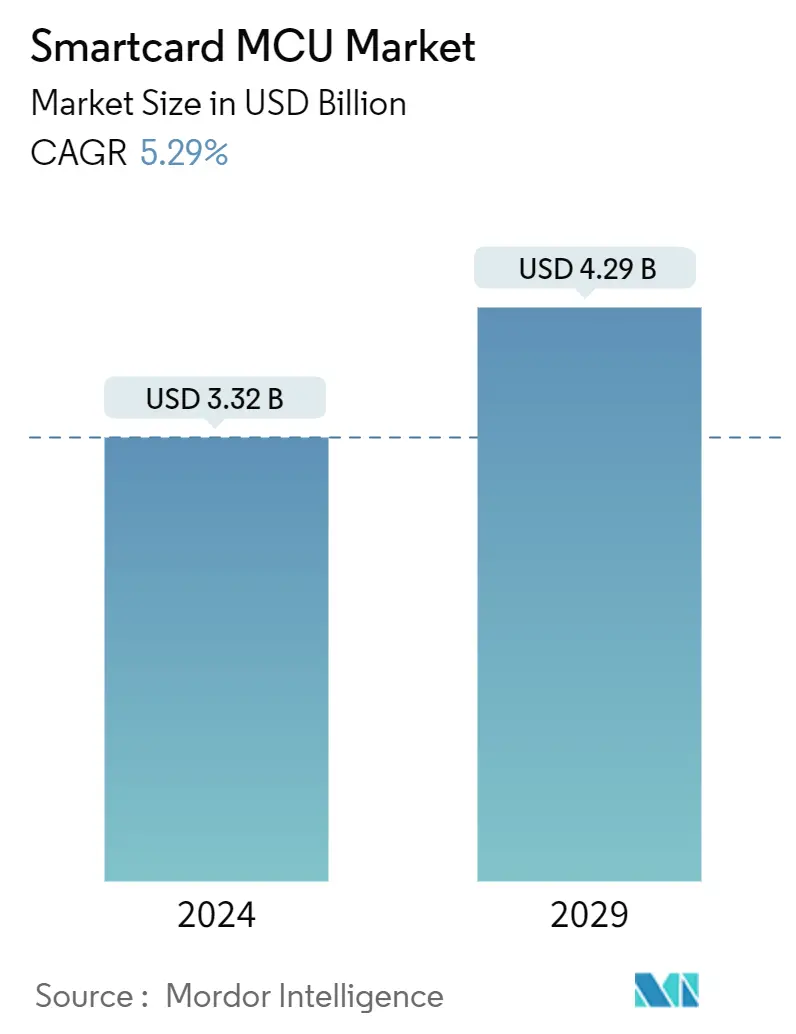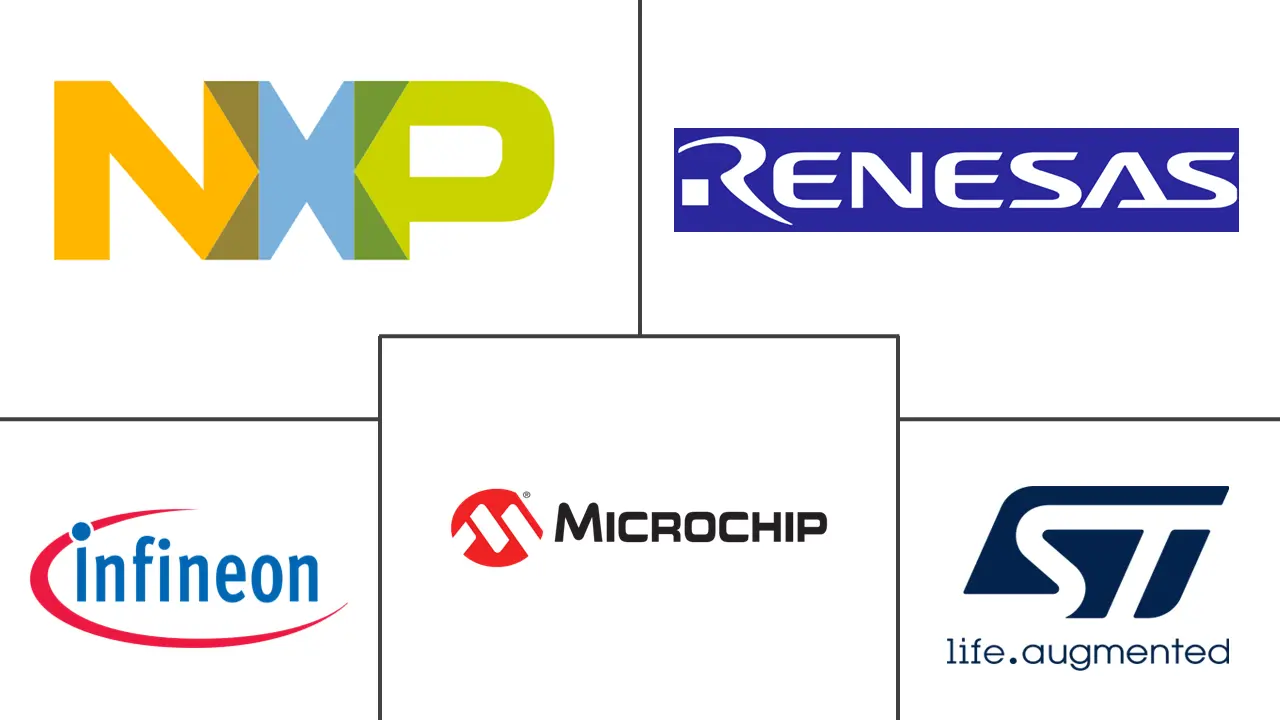Market Size of Smartcard MCU Industry

| Study Period | 2019 - 2029 |
| Market Size (2024) | USD 3.32 Billion |
| Market Size (2029) | USD 4.29 Billion |
| CAGR (2024 - 2029) | 5.29 % |
| Fastest Growing Market | Asia Pacific |
| Largest Market | Asia Pacific |
| Market Concentration | Low |
Major Players
*Disclaimer: Major Players sorted in no particular order |
Smartcard MCU Market Analysis
The Smartcard MCU Market size is estimated at USD 3.32 billion in 2024, and is expected to reach USD 4.29 billion by 2029, growing at a CAGR of 5.29% during the forecast period (2024-2029).
- The Internet's rapid expansion has made electronic shopping a real possibility among computer users if not a habit; nevertheless, the present business model used in electronic commerce applications cannot fully exploit the potential of the electronic medium.
- The market growth is driven by the increasing development in RFID technology and NFC in smart cards. Contactless smart cards, leveraging the rapid evolution of radio frequency identification (RFID) technology, are gaining popularity. These cards use RFID technology to process transactions. Key vendors are concentrating on introducing contactless smart cards due to their growing consumer demand, which is expected to fuel market growth.
- The proliferation of smart card technology in the transportation industry, along with growing government investments in implementing digital technology, drives market growth. Electronic smart cards are now viable alternative payment methods for transport operators. In recent years, many operators and system providers have initiated smart card-based systems either to complement or replace existing payment methods.
- Furthermore, security and miniaturization represent the two fastest-evolving aspects of smart card technology. With global migration to higher security EMV banking cards, the newest generation of smart cards boasts full on-chip cryptography, significantly enhancing industry-wide card security.
- Moreover, smart cards are increasingly being miniaturized into diverse form factors like mini-tags and smart wearables. These trends will persist as smart cards are increasingly employed as a two-factor credential alongside phones or biometrics.
- The primary challenge facing smart cards is their security level. To realize their full potential, smart cards must interact with various interfaces. However, a security issue arises concerning public perception; people might need to be made aware of the personal details stored on their cards, assuming they are secure. Yet, there needs to be an awareness that information extracted from smart cards is collected and analyzed elsewhere.
Smartcard MCU Industry Segmentation
Smart card microcontrollers are specialized microcontrollers designed to be used in smart cards. These cards are used in a variety of applications, such as payment cards, access control cards, and identification cards. These cards are typically more secure and tamper-resistant than general-purpose microcontrollers as they are often used to store sensitive data, such as financial information or personal identification information.
The smartcard MCU market is segmented by product (8-bit, 16-bit, and 32-bit), by functionality (transaction, communication, security & access control), by end-user industry (BFSI, telecommunications, government and healthcare, education, retail, transportation, and other end-user industries), and by geography (North America, Europe, Asia Pacific, and Rest of the World).
The report offers market sizes and forecasts in value (USD) for all the above segments.
| By Product | |
| 8-bit | |
| 16-bit | |
| 32-bit |
| By Functionality | |
| Transaction | |
| Communication | |
| Security and Access Control |
| By End-user Industry | |
| BFSI | |
| Telecommunications | |
| Government and Healthcare | |
| Education | |
| Retail | |
| Transportation | |
| Other End-User Industries |
| By Geography | |
| North America | |
| Europe | |
| Asia | |
| Australia and New Zealand | |
| Latin America | |
| Middle East and Africa |
Smartcard MCU Market Size Summary
The smartcard MCU market is poised for significant growth, driven by advancements in RFID and NFC technologies, which are enhancing the functionality and security of smart cards. The increasing adoption of contactless smart cards, particularly in the transportation sector and digital payment systems, is a key factor propelling market expansion. These cards are becoming integral to various industries, offering secure and efficient payment solutions. The trend towards miniaturization and the integration of advanced security features, such as EMV technology, are further enhancing the appeal of smart cards. As digital payment methods continue to evolve, smart cards are expected to play a crucial role in facilitating secure transactions and improving user convenience.
In the Asia-Pacific region, particularly in India, the adoption of smart card technology is rapidly increasing, supported by government initiatives and the growing demand for digital payment solutions. Smart cards are being utilized across multiple sectors, including banking, healthcare, and transportation, offering enhanced security and efficiency. The market is characterized by intense competition among major players, with a focus on innovation and brand identity to maintain a competitive edge. Recent technological advancements, such as the introduction of biometric card ICs and integrated NFC solutions, are expected to drive further growth in the market. As the demand for contactless payment systems rises, the smartcard MCU market is set to experience substantial expansion in the coming years.
Smartcard MCU Market Size - Table of Contents
-
1. MARKET INSIGHTS
-
1.1 Market Overview
-
1.2 Industry Attractiveness - Porter's Five Forces Analysis
-
1.2.1 Bargaining Power of Suppliers
-
1.2.2 Bargaining Power of Consumers
-
1.2.3 Threat of New Entrants
-
1.2.4 Intensity of Competitive Rivalry
-
1.2.5 Threat of Substitutes
-
-
1.3 Industry Value Chain Analysis
-
1.4 Impact of COVID-19 and Macroeconomic Trends on the Market
-
-
2. MARKET SEGMENTATION
-
2.1 By Product
-
2.1.1 8-bit
-
2.1.2 16-bit
-
2.1.3 32-bit
-
-
2.2 By Functionality
-
2.2.1 Transaction
-
2.2.2 Communication
-
2.2.3 Security and Access Control
-
-
2.3 By End-user Industry
-
2.3.1 BFSI
-
2.3.2 Telecommunications
-
2.3.3 Government and Healthcare
-
2.3.4 Education
-
2.3.5 Retail
-
2.3.6 Transportation
-
2.3.7 Other End-User Industries
-
-
2.4 By Geography
-
2.4.1 North America
-
2.4.2 Europe
-
2.4.3 Asia
-
2.4.4 Australia and New Zealand
-
2.4.5 Latin America
-
2.4.6 Middle East and Africa
-
-
Smartcard MCU Market Size FAQs
How big is the Smartcard MCU Market?
The Smartcard MCU Market size is expected to reach USD 3.32 billion in 2024 and grow at a CAGR of 5.29% to reach USD 4.29 billion by 2029.
What is the current Smartcard MCU Market size?
In 2024, the Smartcard MCU Market size is expected to reach USD 3.32 billion.

